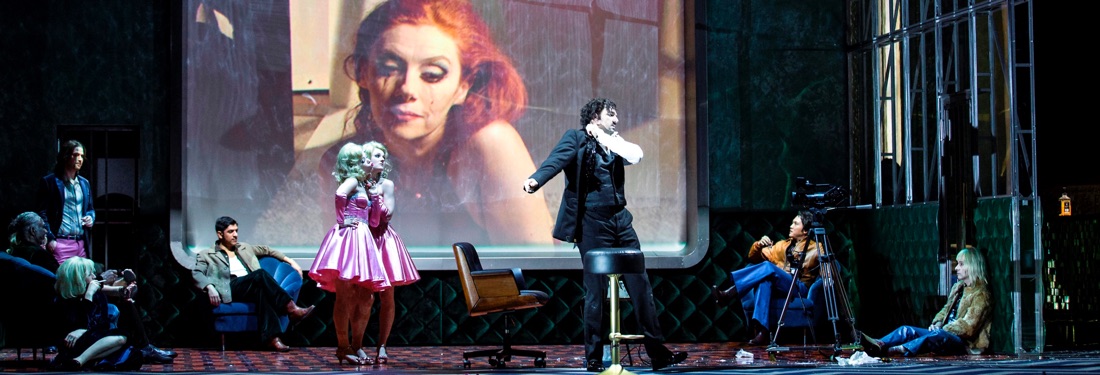

I’m tempted to forgo reviewing it to discuss Biblical legends and their intricate progeny (often the result of mythic intermarriage) and the careers of Weill, Max Reinhardt and Franz Werfel, collaborators on the original piece in 1937. But you can read that stuff elsewhere. (I am indebted to the program notes by Ed Harsh.)
Weill is familiar to us from his sardonic musicals with Bertolt Brecht. Indeed, his style has so familiar a signature that it has inspired a great deal of sublime parody: Dudley Moore’s “The Ballad of Gangster Joe,” Madeline Kahn’s “Das Chicago Song,” the entire score of Cabaret. After he acclimatized to New York, he wrote many shows, both hits and flops, no two in precisely the same genre: Lady in the Dark, Knickerbocker Holiday, One Touch of Venus, Street Scene, Lost in the Stars.
Weill was a Broadway chameleon, but who else could have created so varied and ambitious a portfolio? Perhaps he never found himself—he was only fifty when he died. Or perhaps (like Lipschitz, the murdered artist in Chicago) he was trying to find himself when, happily for us, he found Moss, Ira, Maxwell, Ogden, Elmer and Langston.
The Eternal Road, premiered at the Manhattan Opera House, ran for 153 performances and closed in the red. It came between the two familiar segments of Weill’s career and was the first indication that New York, rather than Vienna, Paris or London, might be his proper place of refuge. For all his familiarity with exported jazz, he had little idea at first what would appeal to the Broadway appetite. (The Brecht collaborations did not appeal here until decades later.)
A young Zionist impresario named Meyer Weisgal dreamed up the idea of a pageant-operetta looking back through Jewish history, and assembled three geniuses deplored by the Nazis. The narrative, a congregation explaining history to an eager but ignorant 13-year-old (his family having assimilated) in a synagogue while anticipating some sort of attack had an immediacy in 1937 and might still do so for those familiar with the saga—much of the audience at Carnegie Hall did not know it, and found it lacking in shape.
According to Mr. Harsh, Weill copied hundreds of Jewish liturgical tunes from the eighteenth and nineteenth centuries from Berlin archives before composing this score, discovering to his surprise that a great many derived from German folk songs and pop tunes of those days, including opera. Indeed, the score often sounds like bad Meyerbeer or elementary Kreutzer.
Weill’s orchestration of the rather too frequent scenes of warlike marches and processions, on the other hand, calls to mind a film score by Alfred Newman or Bernard Herrmann—but without Susan Hayward, the romantic tale of David’s adultery with Bathsheba arouses no very deep emotion.
There was little of Kurt Weill’s familiar pungent harmony until the orgy around the Golden Calf, when at last we (and the ancient Hebrews) could enjoy ourselves. There were other moments and a charming solo or two that might be excerpted, but the melodies were neither evocative nor interesting.
The Collegiate Chorale has already presented Rossini’s take on Moses’ story, which was far more beautiful and dramatic than Weill’s; if they wish to address Jewish history again, may I suggest the less-well-known oratorios of Handel? Splendid music, splendid drama, and I’m not sure New York has heard Alexander Balas or Athalia in the memory of man.
To keep us awake during The Road of Promise, Wendall K. Harrington provided a series of projections to take the place of stage action. Not a few of us passed the time trying to figure out who had painted what. (Rembrandt, Veronese, William Blake.) Not all Harrington’s choices were happy: As Weill exults in the building of King Solomon’s Temple, we were shown David Roberts’ 1842 print of the mosque that occupies its site.
Among the soloists, I was especially delighted with the clear, opalescent ring of Lauren Michelle’s soprano in the roles of Rachel and Naomi. Mezzo Megan Marino sang a charming Ruth. Baritone Mark Delavan feelingly declaimed muddled Abraham and Moses, both of them more sentimental here than in the more interesting versions of Britten and Schönberg.
Jacob and David were performed by a promising tenor named AJ Glueckert, and baritone Philip Cutlip provided a frustrated but dignified Jeremiah. Anthony Dean Griffey, who had the most narrative singing to do as the Rabbi in the surrounding story, performed with an unsettling hollowness lurking below his usually robust tenor, unmooring its profundity; this problem also afflicted bass Justin Hopkins as the Dark Angel.
The thirteen-year-old who asks questions, thereby setting up the story (gee, where did they get that idea?), was played by young Eli Tokash, who has appeared on Broadway in Pippin and in Mary Poppins and has the poise and enunciation of a veteran. Another veteran, Ron Rifkin, was entertaining as the “Adversary” (gee, where did they get that idea?), who exists to set up, challenge and deplore the frustrating history of the Jewish relationship with a passive-aggressive (the word Werfel uses is “whimsical”) deity.
The Chorale were shown to best advantage in the sequences of suffering and rejoicing, when they could moan harmoniously or rejoice greatly. Crowd scenes became them. The Orchestra of St. Luke’s sounded lush as a Technicolor depiction of the desert, but somewhat less extravagant than memories of Biblical epics of yore. More timbrel! Ted Sperling conducted like a man who believed in the score, even when assailed by infidels.

























Comments